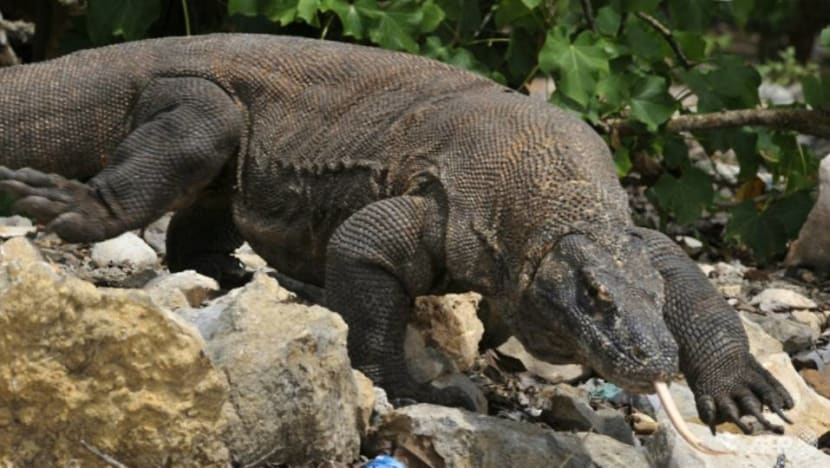‘Endangered’ status puts spotlight on Komodo dragon protection as Indonesia government defends upgrade projects

File photo of a Komodo dragon. (Photo: AFP)
JAKARTA: Weighing up to 150kg and growing up to 3m long, the Komodo dragons are the world’s largest lizards only found in Indonesia’s Komodo National Park and neighbouring Flores Island.
The cannibals eat deer and pigs, and are even capable of attacking humans with their shark-like teeth and poisonous venom.
Despite that, the scaly-skinned animals attract many people to the World Heritage-listed Komodo National Park, which is known for its unique savannah landscape.
“The Komodos are interesting because they have a character unlike any other animal,” tourist guide Yon Johannes in Labuan Bajo, Flores, told CNA, adding that they live on the edge of forests or savannahs.
It is believed the Komodos have existed for millions of years, but they face increasing threats from climate change and infrastructure projects.
Earlier this month, the International Union for Conservation of Nature (IUCN) changed the Komodo dragons’ status from a vulnerable animal to endangered in its Red List of Threatened Species, the first update for the monitor lizards in more than 20 years.
There are only about 3,000 Komodo dragons in the wild and the IUCN said the impacts of climate change are threats to the rare animal.
Human activities such as cutting down forests to make way for infrastructure projects could also threaten the Komodos’ habitat and their existence, said researchers interviewed by CNA.
With IUCN’s reclassification of the monitor lizards, locals have called for the government to reconsider the ongoing projects and pay more attention to environmental protection.
The government, on the other hand, said the IUCN acknowledged that the lizards in the national park were well-protected. The infrastructure projects there were only meant to upgrade old facilities, a minister added.
Related:
RISING TEMPERATURE, SEA LEVELS THREATEN KOMODOS’ HABITAT
The IUCN announcement came after a peer-reviewed paper stressed that global heating would affect the Komodo dragons. Thus, urgent conservation actions are needed to save them from extinction.
The organisation said rising global temperature and sea levels as a result of climate change were expected to reduce the Komodo dragons’ suitable habitat by at least 30 per cent in the next 45 years.
Herpetology curator Evy Arida, who has researched the Komodos extensively, said IUCN’s classification is justified given the number of the Komodos.
“This endangered status is a warning that Indonesia does not take its endemic animals seriously,” she said.
“We also must bear in mind that climate change does not only threaten one species. It so happens that this one species (the Komodo) is endemic to Indonesia so it’s in the limelight, but there are also other animals (in the Komodo National Park),” Mdm Arida, who works at Bogor’s Zoology Museum, said.
Mr Wiratno, director general of natural resources and ecosystem conservation with the Ministry of Environment and Forestry, said he was aware of the findings.
However, he pointed out that the IUCN said Komodo’s subpopulation in the national park was stable and well-protected.
He claimed that the problem was with the lizards in Flores, which is not part of the Komodo National Park. The giant lizards there are under the care of the local government.
“We have been monitoring the Komodo’s population for 17 years in the national park.
“And we protect them by holding patrols, as well as by ensuring their prey such as deer and buffaloes are not being hunted,” Mr Wiratno, who goes by one name, said.
He claimed that the IUCN had never been to the Komodo National Park and he did not understand how the organisation came to its conclusion.
Mr Wiratno opined that the IUCN should have consulted the Indonesian government.
“We have installed chips on about 1,200 Komodo dragons, under their skin.
“We have something like a barcode and if we catch one, we know whether it is one which we have identified before or a new one. We have enough data,” Mr Wiratno told CNA.
Nonetheless, he said officials have yet to identify rising sea levels as a threat.
“We know the Komodos’ behaviours and habitats. It is dangerous for them to be near the beach.
“So we will need to predict the sea levels and how far the sea could reach,” said Mr Wiratno.
ONGOING DEVELOPMENT PROJECTS
Mdm Arida of Bogor’s Zoology Museum said many human activities in Flores endanger the Komodos. These include hunting, smuggling of the animal and burning of the savannah, which causes deer, the Komodos’ prey, to migrate.
The United Nations Educational, Scientific and Cultural Organization (UNESCO) is also concerned about infrastructure projects in the Komodo National Park.
About two years ago, the Indonesian government started to develop the Komodo National Park as part of an integrated tourism master plan for the site and Labuan Bajo, a town west of Flores which is the gateway to the park.
Some have dubbed the infrastructure project “Jurassic Park” after images of a Komodo believed to be on Rinca Island facing a truck went viral last year.
At the 44th session of UNESCO’S World Heritage Committee (WHC) in July, it requested, among others, the authorities to revise the environmental impact assessment for the tourism infrastructure projects on Rinca Island, one of the main islands in the national park, and to resubmit it to the World Heritage Centre for review by IUCN.
It also urged the Indonesian government to halt all tourism infrastructure projects in and around the area that have the potential to impact on its Outstanding Universal Value (OUV), one of the main criteria used by the committee to decide whether a site should be granted a World Heritage status.
Speaking at a virtual press conference on Sep 6, Indonesia’s Tourism and Creative Economy Minister Sandiaga Uno said the current constructions did not violate any World Heritage rules and were meant to repair rundown facilities.
“What has been done, including in the Komodo National Park, was repairing rundown facilities which were fragile and needed renovation, such as shelters for the rangers and so on. And these were according to the needs.
“And it is not like what people have been discussing, as if it is a massive development. We can guarantee it is not like that,” said Mr Uno.
The minister also said that the projects would be completed by October or November, in time for Indonesia’s G20 presidency as the park would be one of the meeting venues.
The new plan would entail certain restrictions to allow sustainable tourism, he added.
Commenting on the infrastructure projects, Mr Wiratno of the Ministry of Environment and Forestry said they were mainly to renovate the old information centre and build an elevated deck for visitors’ safety. These do not affect the OUV, he added.
“The Komodo dragons can walk under the elevated deck,” he said, adding that the infrastructure projects were meant to improve the World Heritage site and the affected area was just 1.3ha. The national park covers an area of 173,000ha, according to the Indonesian government.
“Yes, there are Komodo dragons there, but none of them have been a victim of the development,” he claimed, adding that the development projects were only on Rinca Island.
However, Mr Cypri Jehan Paju Dale, an anthropologist at Kyoto University’s Center for Southeast Asian Studies who researches on conservation, ecotourism and interspecies co-existence at Komodo, was not convinced.
“The Indonesian government and business communities should take the IUCN report and UNESCO’s reminder seriously.
“The central government should revise the whole master plan of tourism development inside Komodo National Park and annul all the business concessions,” he said.
Commenting on the environment ministry’s claim that the development projects only affected 1.3ha of Rinca island, Mr Dale said the effects of such activities were far-reaching.
While the giant lizards only live on several plots in the coastal areas with water sources and forests, the rest of the terrestrial and marine areas are the supporting habitat, he said.
The visitor centres and resort concessions said to be taking place at the islands would harm the specific habitat of the Komodo dragons, he added.
DO NOT DISTURB THE KOMODO DRAGON: LOCALS
Mr Johannes, the tour guide in Labuan Bajo, confirmed many developments were taking place in the town and its surroundings.
“There are a lot of developments here, from infrastructures to new properties, so the pollution levels here are unusually high,” said the Labuan Bajo native.
Another tour guide, Mr Ahmad Fadil, said he was concerned about the well-being of the Komodos.
“That is why I always remind visitors not to take everything, except pictures. Don’t kill anything, except time, and don’t leave anything behind, except footsteps,” he said, adding that tourists should not take corals home or litter when visiting the national park.
Labuan Bajo-based Muhammad Sunardi said he was also very worried about climate change and the developments in the area.
He pointed out that the developments on Rinca Island, currently closed for visitors, could be useful for tourists, but the animals could suffer.
“As a local, I hope the government would consider developments that do not disturb the Komodo dragons. The government should not just think about itself and the stakeholders in developing this Komodo tourist destination.”














